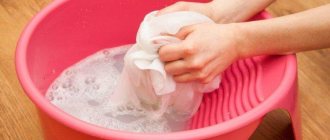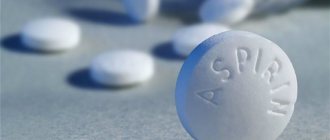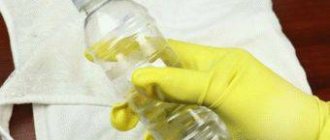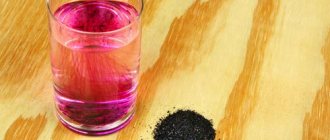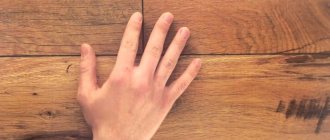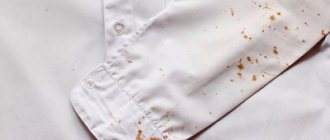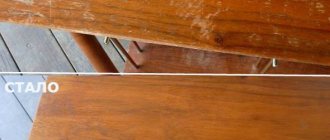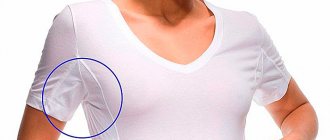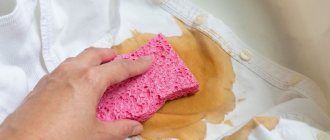Agree - everyone wants to have and keep things in their original form, the way they were the day you purchased them in the store. But is this possible? If things are worn and not used to decorate the wardrobe, a lot of troubles can happen to them, mainly various kinds of stains.
Here you need to be patient and sedative, since it is quite difficult to remove white bleach stains from jeans or a T-shirt.
Before you start restoring things with white bleach stains, you should understand how these stains form. Bleach, unlike glue, does not leave any particles on clothes. Bleach stains form in a completely different way. Attention! Due to its caustic composition, bleach destroys fibers, and the color of the stains depends on the degree of their destruction. Most often, bleach destroys the structure of the paint molecules that paint your things. In this regard, on things of some colors the spots may be white, and on some things they may be slightly yellowish or rusty in color. That is, removing a stain from a caustic substance is an almost impossible task, but there are many ways to restore a thing.
Remove powder from colored clothing
Powder is an indispensable assistant in our care for things, but it can also become a little traitor. It can cause stains on freshly washed clothes. How to remove powder stains from colored clothes?
There are several techniques for this. It’s worth starting with the fact that this is necessary immediately, before you just take the item out of the machine. Load the spoiled food back into the drum and rinse again. Then you can do it a second time.
If you washed colored laundry by hand, then you need to place it in a basin of water for some time so that it softens.
Then add shavings of laundry soap and a little vinegar. Rinse thoroughly.
This should help, even if not the first time.
You can also use boiling water, but this method is only suitable for fresh stains. Pour a stream of fresh boiling water over the stain - that's all the advice.
There is another option, but it requires a lot of attention. This stain removal option will require bleach. It must be carefully applied directly along the radius of the stain. The most important thing is to wash it off in time, otherwise you will get another problem. And we will write about it below.
This is interesting: We easily and quickly knit a sweater for a boy with knitting needles ourselves
Removing Bleach Stains from Denim
If drops of chlorine get on denim, giving the item a boiled-down appearance will help hide the defect. To paint over a white spot on jeans, you will have to use the same bleach that will damage the fabric.
For 10 liters of water you should take 200 ml of product. Place a large container on the hob. Its volume should be within 15 liters. First, the water is heated, but there is no need to bring it to a boil. When the liquid is hot enough, add white. The solution is boiled. At this time, the jeans are folded lengthwise and twisted, as if wrung out. Place the item in boiling water and boil for 20-50 minutes. Processing time depends on the effect to be achieved.
After cooking, the denim item is taken out of the container and rinsed several times in cold water. To get rid of the strong smell of chlorine, you can add 2-3 tbsp while rinsing. l. 9% vinegar.
Remove whiteness from black jeans
How to remove bleach stains from your favorite jeans or a black T-shirt?
Information. Stains from strong cleaning products appear instantly. The black clothes are turning red in places, and it seems that nothing more can be done to help her. The problem is that bleach completely changes not only the color, but also the structure and composition of the fabric.
Do you want to remove a whitish stain from a sweater that is so irritating to your eyes? Have bleach stains ruined your new item? You were cleaning and accidentally spilled Domestos on your clothes?
The first tip that comes to mind in response to the question of how to remove a white stain from black things is to paint them. You can do this by visiting a craft store and purchasing specially designed dyes there.
It is very important to strictly follow the conditions described in the instructions, because dyes exist for different types of fabrics.
Sometimes you need to paint at a temperature of forty degrees, sometimes seventy.
In order to color the product evenly and not spoil it, you can wash it in a washing machine using dyes.
Among other things, you can resort to the following method:
- Dissolve one teaspoon of sodium thiosulfate in a glass of warm water;
- Carefully treat the affected area;
- Leave for a while and then wash as usual.
If the stain remains on the surface of the fabric for more than three days, you can try to remove it with acetylsalicylic acid:
- You need to crush 2 aspirin tablets and mix them with warm water. You cannot stop stirring, since aspirin in the form of regular aspirin tablets is slightly soluble in water;
- Next, we apply this paste to the affected area and leave it under pressure for two to three hours. Well, then, of course, we wash the item with powder.
To remove stains from fabrics of natural origin, for example silk, linen or cotton, use ammonia:
- In one glass of warm water, dilute one teaspoon of ammonia and the same amount of salt;
- Soak damaged clothes in the solution for 30-60 minutes;
- Wash clothes using laundry soap.
Another method that is only suitable if you plan to remove bleach stains from jeans.
The method is old, but quite effective.
To implement it, we will need 10 liters of water, one and a half glasses of white (approximately 250 ml).
This is interesting: Green grass stains eat into fabric, how to remove
Boil water to which whiteness has previously been added. While the water is boiling, tightly twist the gins.
When the water boils, drop tightly rolled jeans into it and boil for about thirty minutes.
After cooking, quickly rinse the jeans in cold running water. Let's enjoy our new jeans, because no one will think that just yesterday these fashionable jeans were part of the home wardrobe and were worn exclusively while cleaning.
Adviсe
- It is strictly prohibited to bleach fabrics with chemicals that contain chlorine.
Ignoring this rule leads to the fact that a white item loses its purity of color and acquires a gray tint.
Remove on dark stain remover
There is another, no less important problem that needs to be dealt with – stain remover stains. It sounds like a pun, but in reality they are the most difficult to deal with.
First of all, you should take into account the type of stain remover you are purchasing, that is, you should understand them in advance. It is important to remember that no matter what the advertising on TV says, there are no stain removers that can remove absolutely all stains without exception.
These funds are divided into several specially targeted groups - you need to know this. For example, a marker remover will not be able to remove a ketchup stain on black trousers, and a stain remover for delicate fabrics will not cope with severe repair stains on rough work uniforms.
Above all else, the most important thing to remember is timely intervention.
After all, the longer the stain remains on the surface of the clothing, the more difficult it is to remove.
When washing in the washing machine, ensure that the required temperature is maintained.
If, after proper washing, the unpleasant mark still appears on the clothes, resort to a full wash again.
Another important tip that should not be neglected, because it prevents an unpleasant problem from arising, is to test the stain remover on an inconspicuous area of the fabric.
You need to start treating the stain from the edges, otherwise there is a risk that it will spread over a larger area.
Important! After removing the stain with a stain remover, you need to thoroughly rinse the clothes in warm water so as not to encounter a new problem - a stain from the stain remover.
As a last resort, take your clothes to the dry cleaner.
Special means
Store windows and shelves are full of various products that, according to manufacturers, can quickly remove unpleasant stains. If possible, you can use them.
The most popular drugs are:
- Antipyatin soap. It has more than once proven its effectiveness in the fight not only against faded stains, but also against many others (greasy, inky, berry).
- Laundry soap. It is better to use not the classic brown, but the new white color. There are more components that will help restore your clothes to their original appearance.
- Bleaches. There are a huge number of brands. This is a great method for removing colored stains on white. The main active ingredient in such preparations is bleach. You should be careful. This type of preparation is only suitable for cotton and linen clothing. It is important to follow the manufacturer’s recommendations regarding the dosage of the product. Too much whiteness can damage the fibers and render the item unusable. It is enough to dilute 2 caps of the drug in 1 liter of water. For delicate fabrics, preference should be given to preparations whose active ingredient is oxygen.
- Stain removers. These products are aimed specifically at eliminating various difficult to remove stains. They contain a large number of enzymes, which are not only capable of fighting dirt on their own, but also enhancing the power of regular washing powder.
Get rid of after washing
If, after washing, your favorite wardrobe item does not get the desired appearance, and is full of stains from powder, detergent, or whiteness, we recommend resorting to the following, no less original methods.
Method No. 1
If a small, barely noticeable stain appears on your favorite T-shirt, but its very appearance causes negative emotions, inspect the item and evaluate the color. Select a felt-tip pen or marker to match the color of the damaged item and carefully, pointwise, paint over the area affected by bleach. After light “makeup”, iron the affected area through a piece of cloth so that the excess dye is absorbed into it.
This is interesting: For beginner knitters - knitting men's sweaters with descriptions and patterns
Method No. 2
This method is more suitable for youth T-shirts, which, even at the production stage, are painted with all sorts of colors, deliberately creating stains and streaks.
To carry out this kind of resuscitation efficiently, you will need fabric paint.
In any sewing store you can find all kinds of colors and shades.
Natural fabrics lend themselves best to resuscitation in this way.
Method No. 3
This method is only slightly different from the previous one: to perform it correctly, you will have to go to a fabric store or a nail store and buy acrylic paint in tubes (which is important).
The viscous consistency of this type of paint will allow you to independently draw an applique, a pattern that will cover up, and maybe even organically play up the stain from the cleaning agent.
After the acrylic paint has completely dried on the product, you need to take a piece of cloth, cover the painted area and iron it. Once heated, the acrylic paint will firmly adhere to dense fabric and the pattern you apply yourself will delight you for a long time!
This method is suitable for all types of tissue, but it is best to carry out such resuscitation on rough tissues.
Method No. 4
Suitable for creative people who know how to embroider with thread or ribbons. It’s very beautiful when a bleach stain on a blouse is skillfully hidden under neat embroidery, especially considering that in recent years embroidery has remained quite a fashionable and stylish wardrobe detail. Perhaps a speck of bleach or Domestos will encourage you to create an incredibly fashionable masterpiece?
Method No. 5
This is the easiest and fastest method and is suitable for almost all types of fabrics that can be heated. In order to save your item, you just need to buy a patch at any hardware store. Then, at home, you smooth out the damaged item, put the patch you like on it and iron it thoroughly. Fast and convenient!
Using ammonia to fight stains
Add ammonia to your wash. Ammonia is an alkaline solution that can be very good at removing grease and dirt. You can use it as a bleach by adding a small amount to your regular wash cycle.
- You should never mix bleach with ammonia as the reaction produces highly toxic and potentially fatal fumes.
- Work in a well-ventilated area and wear rubber gloves when using ammonia.
- The first time you wash an item after treatment, be sure to keep the garment separate from other clothing. Concentrated ammonia can damage and stain clothing.
